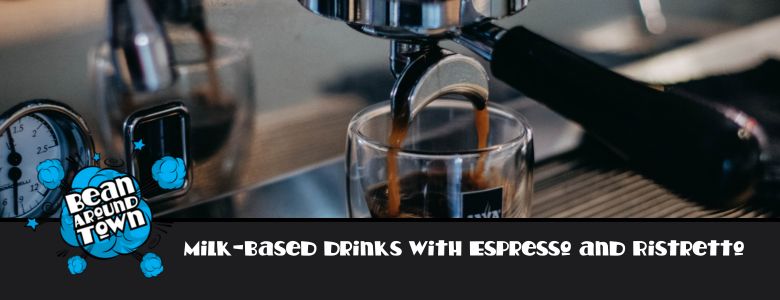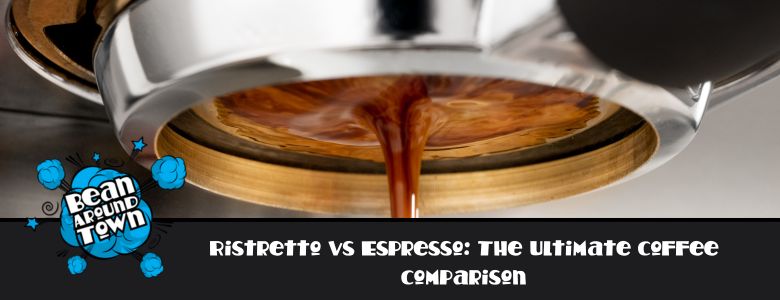When it comes to the world of concentrated coffees, two frequently discussed options are ristretto vs espresso. The primary difference between them lies in their brewing methods and flavour profiles. In this article, we’ll break down these distinctions to help you understand which might suit your taste preferences.
Key Takeaways
- Espresso offers a bold, rich flavour and is characterised by its crema, while ristretto provides a sweeter, more concentrated taste due to its shorter extraction time.
- Crafting both espresso and ristretto requires precise control of grind size, brewing time, and water temperature to maximise flavour and achieve the desired taste profile.
- Espresso serves as a base for many milk-based drinks, while ristretto enhances creaminess and sweetness, making it an appealing choice for those who prefer less bitterness.

Understanding Espresso
Often hailed as the cornerstone of numerous coffee beverages, espresso is a robust coffee concentration created by pressing hot water through finely ground beans. This cherished espresso stands out for its potent taste, velvety crema, and intense flavour that distinguishes it from other varieties of coffee drinks.
The Essence of Espresso
The appeal of espresso is found in its robust essence and powerful identity. It has become a foundational element in coffee shops globally thanks to its deep taste, striking crema, and unique scent that defines the beverage. The inviting golden foam topping each espresso shot adds visual charm and enriches the intricate flavour profile. Darker roasted beans are preferred for making espresso because they yield a velvety texture and intense flavour concentrations highly valued by experts.
Espresso is more than just a drink. It brings people together for meaningful conversations and represents Italian tradition. Whether enjoyed in a bustling café or a quiet corner, making the perfect espresso takes skill and precision. Using an espresso machine with care and expertise turns brewing into more than just a process—it becomes a blend of tradition and craftsmanship.
Brewing an Espresso Shot
Creating an ideal espresso shot requires pushing hot water through coffee beans ground to a fine consistency, utilising high pressure. To attain proper extraction, the grind size of the coffee, along with the temperature and pressure of the water, must be exact. A finer grind is employed as it heightens resistance and allows better dissolution of the coffee, which is vital for achieving espresso’s distinctive thick and concentrated texture.
Yet, missteps in regulating water temperature or selecting an appropriate grind size can disrupt extraction, resulting in flavours that fall short of expectations. By honing these variables, one ensures that each shot of espresso presents its characteristic intense and deep taste.
What Makes Ristretto Unique?
Ristretto, a variation of espresso, offers a unique twist on the traditional brewing method. Unlike the standard espresso shot, ristretto means ‘restricted’ in Italian, indicating its reduced volume and more concentrated flavour.
This short espresso shot is not a distinct drink but a specific ratio within the family of espresso shots.
Defining Ristretto
Ristretto distinguishes itself with a shorter extraction time than the usual espresso, yielding a more pronounced sweet taste and reducing bitterness. This variation of espresso is crafted using finely ground coffee beans combined with a reduced amount of water, creating a denser and creamier consistency. A ristretto shot typically has an approximately 15-second brew time, which limits the latter part of extraction, thus diminishing the release of bitter compounds.
Ristretto is a favourite among coffee lovers with its bold, rich flavour and smooth texture. Its intense taste carries hints of dark chocolate and caramel. For those wanting a stronger coffee experience, ristretto is a great choice. It’s more intense than a standard espresso but with less bitterness and a richer flavour from the beans.
Crafting a Ristretto Shot
To make the perfect ristretto, a 1:1 coffee-to-water ratio is used, creating a strong and rich coffee. This method requires a finer grind and a shorter extraction time, usually between 15 to 20 seconds, to bring out the right balance of sweetness.
Effectively managing grind size and brew time enhances the flavour profile and guarantees that the ristretto shot provides its characteristic intense yet velvety taste.
Comparing Flavour Profiles
Espresso and ristretto each have unique flavours, offering different taste experiences to match personal preferences. Espresso is known for its balanced mix of bitterness, acidity, and sweetness, creating a rich and full-bodied flavour.
These beverages can display an array of flavours, including earthy, nutty, fruity, and floral elements, which enhance their intricate character.
Espresso’s Flavour Profile
The taste of espresso is significantly shaped by the selection and roasting of coffee beans, with premium beans from various sources enhancing its strong and intricate flavour profile. The slight bitterness of this beloved drink adds to its bold and rich character, making it a favourite among espresso lovers.
Ristrettos Flavour Profile
On the contrary, ristretto is known for its sweeter and more robust flavour, which results from using less water and a shorter extraction time. This concentrated shot yields a smoother texture on the palate while bringing out hints of dark chocolate and caramel that heighten its sweetness and diminish bitterness.
To maximise the flavour profile of ristretto, freshly roasted beans, especially those ranging from dark to medium-dark roasts, are recommended.
Strength and Concentration Differences
Due to distinct preparation techniques, espresso and ristretto exhibit considerable differences in strength and concentration. Espresso is prepared using more water, producing a potent caffeine punch and a rich and full-flavoured profile.
Espresso’s Strength
Espresso is renowned for its strong and rich qualities, marked by a concentrated amount of caffeine. This makes it the drink for those looking to enjoy a potent and stimulating coffee experience.
The vigorous taste of espresso comes from an aggressive brewing process that extracts the most flavour from the coffee grounds.
Ristretto’s Potency
Despite ristretto’s more robust flavour profile, it contains less caffeine than espresso because of the reduced extraction time. This condensed form of espresso presents a potent coffee encounter that is sweeter and less pronouncedly bitter.
Ristretto boasts an increased concentration of flavours, which leads to a syrupy, luxurious mouthfeel, amplifying the perceived sweetness in its overall flavour.
Serving Suggestions
Properly presenting espresso and ristretto can significantly improve these beverages’ taste profiles and complete sensory enjoyment.
Perfect Presentation
Traditionally, espresso is presented in a demitasse cup accompanied by a saucer, highlighting the beverage’s dense crema and lending elegance to its service. The ristretto, known for its greater concentration than espresso, is typically served in an even smaller cup that underscores its strong character.
The right glassware enhances both the look and enjoyment of the drink, making every sip more satisfying.
Ideal Pairings
Coffee becomes even better when paired with foods that highlight the flavours of espresso and ristretto. The potent taste profile of ristretto is excellently complemented by decadent desserts, including tiramisu or dark chocolate cake, which emphasise its strong flavours.
On the other hand, espresso’s bold flavour pairs perfectly with crunchy treats like almond biscotti or croissants. This combination blends sweetness with rich intensity, making each sip more enjoyable.
Customising Your Brew
Customising your espresso and ristretto involves selecting the right coffee beans and adjusting brewing parameters to achieve your desired flavour.
Bean Selection
Selecting the appropriate coffee beans is essential when creating top-notch espresso and ristretto because it profoundly affects these beverages’ taste and overall enjoyment. By trying out various degrees of roasting and sourcing beans from different regions, one can notably alter the flavour profile and body of espresso and ristretto, resulting in distinctive coffee experiences catering to individual preferences.
The freshness of the beans plays a critical role. Using old or stale beans can drastically diminish the taste and excellence of your coffee preparation.
Adjusting Brew Parameters
Tweaking the grind size, water temperature, and brewing duration is crucial in refining your espresso and ristretto shots. Should a ristretto shot exhibit a sour taste, amending the grind coarseness or lengthening the brew time could rectify the flavour profile.
When preparing espresso, it’s widely accepted that an optimal brew ratio is 1:2—this indicates that two grams of liquid should be produced for each gram of coffee. To ensure ideal extraction yielding superior flavour notes, maintain your water temperature between 88°C and 94°C.
Exploring Variations
Exploring options like double espresso and double shot ristretto offers a stronger and more intense coffee experience.
Double Espresso
Caffé Doppio, commonly referred to as a double espresso, is prepared with roughly 20-22 grams of coffee grounds and yields a beverage volume ranging from 44-52 ml. It necessitates using twice the amount of coffee compared to its counterpart and typically needs around 50 ml of water for extraction versus the 25 ml employed in making a single espresso.
Consequently, consuming a double espresso leads to an intensified coffee encounter that boasts an augmented flavour profile, greater complexity, and an ample crema atop the drink.
Double Ristretto
Using the same coffee quantity as in a double espresso, a double ristretto is crafted with reduced water to intensify its flavour. The result is a more decadent and velvety taste profile, with an intricate sweetness that typically outshines regular double espresso.
The double ristretto is an ideal choice for individuals seeking an amplified and potent coffee encounter.

Milk-based drinks with Espresso and Ristretto
Drinks based on milk and incorporating espresso or ristretto provide distinct taste experiences, as each base adds a unique flavour profile to the final beverage.
Espresso in Milk-Based Drinks
Espresso is the cornerstone of numerous milk-infused coffee shop favourites, such as lattes and cappuccinos. It delivers a deep and potent flavour that significantly elevates these beverages’ taste profile. The combination of espresso and milk creates a perfect balance, making it a popular choice in coffee shops around the world.
This bold espresso flavour pairs seamlessly with the smoothness of milk, yielding an enjoyable beverage savoured by those who cherish the essence of coffee flavour.
Ristretto in Milk-Based Drinks
Incorporating ristretto instead of standard espresso into milk-based beverages results in a richer and more pronounced sweetness, offering an intensified flavour profile. Ristretto’s increased coffee oil content amplifies the creaminess and reduces bitterness within these drinks, catering mainly to those with a palate favouring milder flavours.
Milk-based drinks like lattes and Long Blacks often use ristretto for a smoother, sweeter flavour.
Brewing Techniques: Espresso vs Ristretto
The methods used to brew espresso and ristretto highlight each beverage’s distinctive features and taste profiles.
Espresso Brewing Process
The production of a standard espresso shot involves a brewing time ranging from 25 to 30 seconds, during which water at approximately 93.3°C is passed through finely ground coffee. The grind size must remain consistent and exact to make an impeccable espresso. This boosts resistance and facilitates the dissolution of coffee grounds, allowing for the complete extraction of its deep flavours.
Uniformity in how tightly the coffee is tamped down and using water with suitable mineral content are both pivotal factors. Utilising water overloaded with minerals can adversely affect the extraction process. Hence, attention must be given to the quality and temperature of water used to guarantee that each espresso has a distinctive, strong and rich taste.
Ristretto Brewing Process
The process of making a ristretto shot includes utilising a briefer extraction period, which is usually between 15 to 20 seconds. The reduced brew time leads to an amplified concentration and robustness in the flavour profile, enhancing the natural sweetness of the coffee while diminishing its bitterness due to the limited volume of water that passes through.
To capture the distinctive taste of a ristretto, a finer grind size is essential than that typically used for espresso. To discover your ideal version of this intense flavour experience, don’t hesitate to experiment with variables such as grind size, water temperature, and extraction timing until you find your preferred personal balance.
Common Mistakes to Avoid
Mastering the subtle art of brewing espresso and ristretto is crucial to extracting the optimal flavours while avoiding prevalent errors.
Espresso Pitfalls
A common mistake when making espresso is choosing the wrong grind size, which can significantly influence both extraction and the overall flavour of the coffee. Maintaining a consistent coffee dose is vital, as differing amounts may cause inconsistent shot quality. To guarantee optimal taste, it’s recommended to use beans that have been roasted within the past six weeks.
If these aspects are ignored, one might end up with an inferior espresso with a disappointing flavour profile.
Ristretto Missteps
During the preparation of ristretto, there is a significant chance of under-extraction, which can impart an excessively sour taste to the coffee. This problem might be due to using an unsuitable grind size or not brewing at the correct temperature. It’s crucial to keep the grind size uniform. Otherwise, inconsistent extraction may happen, causing the flavour of your coffee to swing between bitter and sour.
Applying pre-infusion is beneficial as it allows for even saturation of the coffee grounds before complete extraction. This process balances the flavours and helps create a smoother, more refined ristretto shot.
Summary
Grasping the distinctions between espresso and ristretto can enhance your appreciation for coffee. Espresso is known for its substantial caffeine kick and intense flavour, forming the base of various popular coffee drinks. In contrast, a ristretto provides an even more potent flavour with a sweeter note and creamier texture, presenting an interesting variation on conventional espresso.
Perfecting the art of brewing while steering clear of typical errors is crucial to tailoring your espresso or ristretto to align with your taste preferences. Whether you’re inclined towards the powerful punch of traditional espresso or favour the rich sweetness characteristic of a ristretto shot, each brings unique and enjoyable dimensions to your coffee experience that are worth delving into. Whether at a coffee shop or brewing at home, keep these details in mind to fully enjoy every sip.
Frequently Asked Questions
What is the main difference between espresso and ristretto?
The main difference between espresso and ristretto is that ristretto uses less water and a shorter extraction time, making it sweeter and more concentrated in flavour.
So, if you’re looking for a more prosperous, bolder taste, ristretto is the way to go!
How does the caffeine content compare between espresso and ristretto?
Espresso usually has more caffeine than ristretto because it uses more water and takes longer to extract.
So, if you’re looking for a more decisive caffeine kick, espresso is the way to go!
Can I use the same coffee beans for both espresso and ristretto?
You can use the same coffee beans for both espresso and ristretto!
Just remember to adjust the grind size and brewing parameters for the best taste.
What are some common mistakes to avoid when brewing espresso?
To brew a great espresso, avoid using the wrong grind size and inconsistent coffee dosing, and use fresh beans.
Getting these right can enhance your espresso experience!
How does ristretto enhance milk-based drinks?
Ristretto elevates milk-based drinks by adding a sweeter, more concentrated flavor while keeping things smooth and creamy. It also reduces bitterness, making every sip just that much better!






